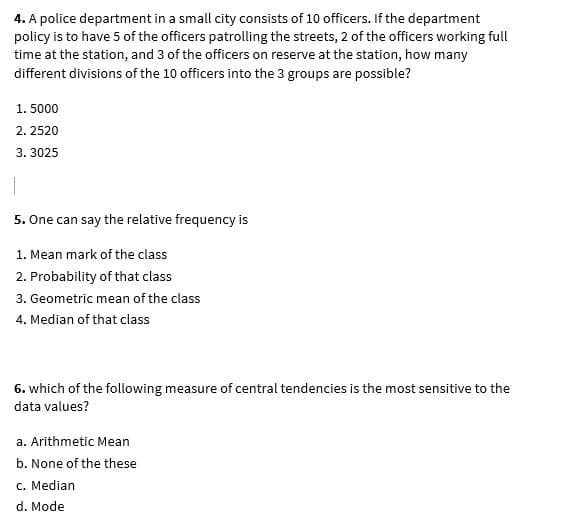4. A police department in a small city consists of 10 officers. If the department policy is to have 5 of the officers patrolling the streets, 2 of the officers working full time at the station, and 3 of the officers on reserve at the station, how many different divisions of the 10 officers into the 3 groups are possible? 1. 5000 2. 2520 3. 3025 5. One can say the relative frequency is 1. Mean mark of the class 2. Probability of that class 3. Geometric mean of the class 4. Median of that class 6. which of the following measure of central tendencies is the most sensitive to the data values? a. Arithmetic Mean b. None of the these c. Median d. Mode
4. A police department in a small city consists of 10 officers. If the department policy is to have 5 of the officers patrolling the streets, 2 of the officers working full time at the station, and 3 of the officers on reserve at the station, how many different divisions of the 10 officers into the 3 groups are possible? 1. 5000 2. 2520 3. 3025 5. One can say the relative frequency is 1. Mean mark of the class 2. Probability of that class 3. Geometric mean of the class 4. Median of that class 6. which of the following measure of central tendencies is the most sensitive to the data values? a. Arithmetic Mean b. None of the these c. Median d. Mode
Glencoe Algebra 1, Student Edition, 9780079039897, 0079039898, 2018
18th Edition
ISBN:9780079039897
Author:Carter
Publisher:Carter
Chapter10: Statistics
Section: Chapter Questions
Problem 13PT
Related questions
Question

Transcribed Image Text:4. A police department in a small city consists of 10 officers. If the department
policy is to have 5 of the officers patrolling the streets, 2 of the officers working full
time at the station, and 3 of the officers on reserve at the station, how many
different divisions of the 10 officers into the 3 groups are possible?
1. 5000
2. 2520
3. 3025
5. One can say the relative frequency is
1. Mean mark of the class
2. Probability of that class
3. Geometric mean of the class
4. Median of that class
6. which of the following measure of central tendencies is the most sensitive to the
data values?
a. Arithmetic Mean
b. None of the these
c. Median
d. Mode
Expert Solution
This question has been solved!
Explore an expertly crafted, step-by-step solution for a thorough understanding of key concepts.
This is a popular solution!
Trending now
This is a popular solution!
Step by step
Solved in 2 steps

Knowledge Booster
Learn more about
Need a deep-dive on the concept behind this application? Look no further. Learn more about this topic, statistics and related others by exploring similar questions and additional content below.Recommended textbooks for you

Glencoe Algebra 1, Student Edition, 9780079039897…
Algebra
ISBN:
9780079039897
Author:
Carter
Publisher:
McGraw Hill

Holt Mcdougal Larson Pre-algebra: Student Edition…
Algebra
ISBN:
9780547587776
Author:
HOLT MCDOUGAL
Publisher:
HOLT MCDOUGAL

Glencoe Algebra 1, Student Edition, 9780079039897…
Algebra
ISBN:
9780079039897
Author:
Carter
Publisher:
McGraw Hill

Holt Mcdougal Larson Pre-algebra: Student Edition…
Algebra
ISBN:
9780547587776
Author:
HOLT MCDOUGAL
Publisher:
HOLT MCDOUGAL